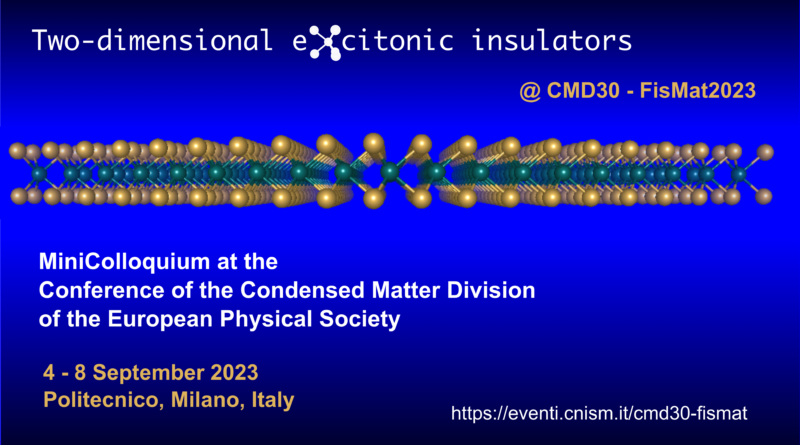Two-dimensional excitonic insulators @ CMD30 – FisMat2023
The field of the excitonic insulator is moving extremely fast. To keep up to date, we are organising a three-day MiniColloquium at the Conference of the Condensed Matter Division of the European Physical Society (CMD30 – FisMat2023), spanning three half-days, dedicated discussion and posters sessions.
The organisers are Hope Bretscher (MPI, Germany), Elisa Molinari (UniMoRe, Italy) and Massimo Rontani (Cnr-Nano, Italy)
Monday 4th to Friday 8th September 2023
Politecnico in Milano, Italy
How to submit your contribution
You can submit a contribution before April 15th May 1st 2023.
Please note that, due to the format of the conference, we will accept only contributed talks and posters, and will not consider submissions for invited talks.
- Go to https://eventi.cnism.it/cmd30-fismat
- Click on Submit your contribution by clicking here.
- First page: fill in authors’ data.
- Second page:
- in line 2 choose Minicolloquia.
- In line 3 select Two-dimensional excitonic insulators under the section Minicolloquia – Fundamental Condensed Matter.
- Second page:
- Choose ‘Oral’ or ‘Poster’ presentation. Please do not choose ‘Oral (invited)’.
- Write your title and abstract. The abstract text allows for maximum 2500 characters (spaces excluded).
- Third page: check data and submit.
Whereas we will be unable to assign an oral contribution to each participant, we will organize a special session dedicated to collective discussion, in order to make the Colloquium interesting and fruitful for all attendees.
The Minicolloquium: Two-dimensional excitonic insulators
By collecting the key actors of theoretical and experimental research, who are spread among different communities, this MiniColloquium aims at in-depth analysis of common themes and novel challenges, to progress our understanding of interacting systems in low dimensions.
The research on excitonic insulators has its origin in a heretic prediction formulated more than 50 years ago by a group of visionary physicists, including Leonid Keldysh and Walter Kohn: If a narrow-gap semiconductor, or a semimetal with slightly overlapping conduction and valence bands, failed to fully screen its intrinsic charge carriers, then excitons — electron-hole pairs bound together by Coulomb attraction — would spontaneously form. This would destabilize the ground state, leading to a reconstructed ‘excitonic insulator’ — a condensate of excitons at thermodynamic equilibrium. This chimeric phase shares fascinating similarities with the Bardeen-Cooper-Schrieffer superconductor: a distinctive broken symmetry, inherited by the exciton character, and collective modes of purely electronic origin. Its observation was deterred for many decades by the trade-off between competing effects in the semiconductor: as the size of the energy gap decreases, favoring spontaneous exciton generation, the screening of the electron-hole interaction increases, suppressing the exciton binding energy.
In the last two years, mounting evidence has been accumulating in 2d materials, as they combine optimal band structures, poor screening behavior, truly long-ranged interactions, and giant excitonic effects. New electron-hole bilayers hold promise of room-temperature superfluid behavior [1-4], whereas signatures of the long-sought bulk phase were found in monolayers [5-7]. Excitonic materials exhibit other kinds of order as well: a variety that includes topological insulators [6-8], ferroelectrics [8,9], unconventional superconductors [6-7,9], often depending on tiny variations of tunable parameters, such as doping, pressure, strain. This introduces new urgent and far-reaching questions, concerning the role of excitonic correlations in a plethora of allegedly unrelated phenomena, whose interplay is just beginning to be explored. At the same time, the long-term challenge of establishing the excitonic insulator through the signatures of macroscopic quantum coherence is attracting renewed interest in this class of materials.
References:
[1] Liu, X. et al. Crossover between strongly coupled and weakly coupled exciton superfluids. Science 375, 205-209 (2022). https://www.science.org/doi/10.1126/science.abg1110
[2] Ma, L. et al. Strongly correlated excitonic insulator in atomic double layers. Nature 598, 585-589 (2021). https://www.nature.com/articles/s41586-021-03947-9
[3] Chen, D. et al. Excitonic insulator in a heterojunction Moiré superlattice. Nature Phys. 18,1171–1176 (2022). https://www.nature.com/articles/s41567-022-01703-y
[4] Zhang, Z. et al. Correlated interlayer exciton insulator in heterostructures of monolayer WSe2 and Moiré WS2/WSe2. Nature Phys. 18, 1214–1220 (2022). https://www.nature.com/articles/s41567-022-01702-z
[5] Bretscher, H. et al. Imaging the coherent propagation of collective modes in the excitonic insulator Ta2NiSe5 at room temperature. Science Adv. 7, eabd6147 (2021). https://www.science.org/doi/10.1126/science.abg1110
[6] Jia, Y. et al. Evidence for a monolayer excitonic insulator. Nature Phys. 18, 87–93 (2022). https://www.nature.com/articles/s41567-021-01422-w
[7] Sun, B. et al. Evidence for equilibrium exciton condensation in monolayer WTe2. Nature Phys. 18, 94–99 (2022). https://www.nature.com/articles/s41567-021-01427-5
[8] Varsano, D. et al. A monolayer transition-metal dichalcogenide as a topological excitonic insulator. Nature Nanotech. 15, 367–372 (2020). https://www.nature.com/articles/s41565-020-0650-4
[9] Ataei, S. et al. Evidence of ideal excitonic insulator in bulk MoS2 under pressure. PNAS 118, e2010110118 (2021). https://www.pnas.org/doi/abs/10.1073/pnas.2010110118


Pingback: Two-dimensional excitonic insulators Workshop – Excitonic Insulator